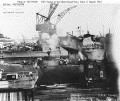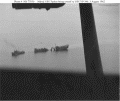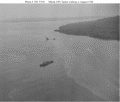Click On Image
For Full Size Image |
Size |
Image Description |
Contributed
By |
No Photo
Available | - |
Samuel Tucker was born on 1 November 1747 in Mablehead, Massachusetts. He began his naval career in the spring of 1760 as a cabin boy in the Massachusetts Bay Colony warship, King George. He subsequently sought his fortune in the merchant service, rising to command of a ship in July 1774. Tucker was in England at the outbreak of the American War for Independence, but returned to Massachusetts in the autumn of 1775. Upon his return to the colonies, Tucker was selected by General George Washington to command a small flotilla of armed schooners which he had purchased and fitted out to prey on the shipping which was bringing supplies from England to America to support British troops in the colonies. Tucker also served as commanding officer of the schooner Franklin. In that schooner and later in schooner Hancock, Tucker swept the seas around Boston and off the Massachusetts coast, taking many prizes in the year 1776. His first, taken jointly with the schooner Lee, came on 29 February, when the two Continental ships cornered the 300-ton Henry and Esther, bound for Boston laden with wood from Halifax, Nova Scotia. In April 1776, in Hancock, Tucker sighted two supply brigs making for Boston. Standing in to the harbor, very near to the protecting cannon of British warships anchored in the roadstead, he soon captured brigs Jane and William, out of Ireland. Tucker brazenly sailed up and took both from beneath the very noses of the British Navy, escaping with the two ships and their valuable cargoes of foodstuffs and other items needed by the Continental Army. Because of his distinguished record, Tucker was given command of the new Continental Navy frigate Boston in March 1777. On 21 May, Boston and sister frigate Hancock set sail from Boston to raid the King's commerce on the high seas. Cruising in the North Atlantic, eight days out of their home port, the raiders captured a small brig laden with cordage and duck. On 30 May, they sighted a convoy of troopships escorted by the 64-gun HMS Somerset, which soon set course to engage Manley's Hancock. Sizing up the situation in his experienced mariner's eye, Tucker bent on sail to go after the transports to wreak havoc among them. At that point, Somerset's commanding officer decided not to engage Hancock, since his primary mission was to protect the transports. Thus, Hancock escaped nearly certain devastation at the hands of the 64-gun Britisher. Tucker's timely action and good ship handling were undoubtedly major factors in the Briton's decision. On 7 June, Boston and Hancock engaged HMS Fox and made her a prize after a heated battle. One month later, on 7 and 8 July 1777, HMS Flora, HMS Rainbow, and HMS Victor attacked the three Continental ships and took Hancock and Fox. Only Boston escaped. For the remainder of 1777, Tucker, in Boston, carried out commerce-raiding forays in the North Atlantic and off the northeast coasts before being selected for a special mission. On 13 February 1778, Capt. Samuel Tucker was rowed ashore to Braintree, Mass., where he soon sat down for a hasty and early meal with the family of John Adams. Soon, Adams, the newly appointed minister to France, and his son, John Quincy, were taken out to Boston and lodged on board as preparations for heading out to sea were completed. Encountering heavy seas and wind halfway across the Atlantic, Boston nearly dismasted in a gale. On another occasion, three British warships gave chase to the solitary Continental frigate and its distinguished passenger. The unpleasant surroundings of a dank and dismal English prison were not relished by anyone, least of all Adams, who would have been considered a traitor to the crown. Avoiding contact with British ships as much as possible, Tucker was finally forced to fight. Encountering a British privateer, Tucker maneuvered Boston to cross the enemy's "T." With devastating effect, Boston's guns thundered and sent shot down the length of the Britisher, and soon, the Briton struck her colors. Arriving safely at Bordeaux on 1 April, Adams would have stories to tell i n future days about his eventful cruise with Samuel Tucker in Boston. Cruising in European waters from the spring of 1778 until the fall of that year, Tucker took four more prizes before returning to Portsmouth, N.H., on 15 October. In 1779, two cruises in the North Atlantic netted nine prizes for Tucker and his mariners before orders sent Boston to Charleston, S.C., to help defend that port against the British onslaught. On 11 May 1780, Charleston surrendered, after a siege, and the warships in harbor were captured, along with most of their officers and men. Tucker was among the prisoners but would not remain so for long, as he received parole on 20 May and was exchanged for British Capt. Wardlaw, whom Tucker had captured when Boston took HMS Thorn in September 1779. On 11 January 1781, Tucker assumed command of Thorn, now a privateer. After taking seven prizes, he was again captured in an engagement with HMS Hind off the mouth of the St. Lawrence River. He and his crew were treated kindly and taken to Prince Edward Island. One day, having had permission to go to Halifax, Tucker escaped and made his way to Boston. In an era where chivalry in war was still very much alive, Tucker wrote a letter of apology to the British garrison commander for his escape. At his own request, Tucker was paroled. When the war had ended and independence had been secured for the fledgling United States, Tucker received hearty thanks from Congress. During the years following the establishment of peace, the old mariner from Marblehead sailed packets from America to Bremen, Germany, until he retired to farming, in Maine, in 1792. Yet, when the young United States once again went to war with Britain in the War of 1812, Samuel Tucker returned to active service, commanding a schooner which protected the coast of Maine from British privateers. In 1813, he captured the British privateer Crown in a short, sharp engagement, putting an end to the harassment of Maine coastal trade which had been posed by the Briton. Changing his residence to Massachusetts, Tucker settled down once again to a life of farming. In 1823, he was awarded a small pension, retroactive to 1818. After holding positions of public trust in his home state of Massachusetts and having lived a life of adventure on the high seas, Samuel Tucker died at the age of 86 in Bremen, Maine, on 10 March 1833. | Robert M. Cieri |

| 134k | Undated, location unknown. | Tommy Trampp |

| 87k | Photo #: NH 60331. USS Tucker (DD-374) completion photograph, taken off the Norfolk Navy Yard, Portsmouth, Virginia, 2 March 1937. Official U.S. Navy Photograph, from the collections of the Naval Historical Center. | Tony Cowart |

| 107k | Photo #: NH 59936. USS Tucker (DD-374) completion photograph, taken off the Norfolk Navy Yard, Portsmouth, Virginia, 2 March 1937. Official U.S. Navy Photograph, from the collections of the Naval Historical Center. | Tony Cowart |

| 127k | USS Tucker (DD-374) completion photograph, taken off the Norfolk Navy Yard, Portsmouth, Virginia, 2 March 1937. Official U.S. Navy Photograph, from the collections of the Naval Historical Center. Photo #: NH 59935. | Robert Hurst |

| 156k | March 30 1937, leaving Norfolk. | Ed Zajkowski |

| 57k | Photo #: NH 99206. USS Tucker (DD-374) underway in Massachusetts Bay, 17 November 1937. Official U.S. Navy Photograph, from the collections of the Naval Historical Center. | Tony Cowart |

| 66k | Photo #: NH 99207. USS Tucker (DD-374) underway in Massachusetts Bay, 17 November 1937. Official U.S. Navy Photograph, from the collections of the Naval Historical Center. | Tony Cowart |

| 147k | Photo #: NH 99205. USS Tucker (DD-374) underway on 28 April 1938. Official U.S. Navy Photograph, from the collections of the Naval Historical Center. | Tony Cowart |

| 89k | USS Tucker steaming past a Naval Air Station (probably NAS North Island, San Diego, California) on 22 October 1938. The airplane parked in the foreground is a PBY-3 (Bureau # 0857). U.S. Naval Historical Centre, photo # NH 101683. | Robert Hurst |

| 93k | Photo #: NH 101665. USS Tucker (DD-374) at anchor, during the later 1930s. U.S. Naval Historical Center Photograph. | Tony Cowart |

| 123k | Photo #: NH 63135. USS Tucker (DD-374) with canvas hung from her masts, during the later 1930s. This is probably an experiment in using makeshift sails to extend the ship's low speed cruising range. U.S. Naval Historical Center Photograph. (A note from Sinclair Geraing; "As far as I can tell, the notion of, essentially, spreading the ship's awning vertically to make a sail was entirely LCDR Gearings idea.") | Tony Cowart |

| 68k | Photo #: NH 68074. USS Tucker (DD-374) in a harbor, circa the later 1930s. Courtesy of Donald M. McPherson, 1969. U.S. Naval Historical Center Photograph. | Tony Cowart |

| 75k | Two views of the Tucker as seen from the USS Shaw pre World War II. From the collection of Edmund Buijnarowski. | Dave Pallante |

| 164k | As above. | Dave Pallante |

| 102k | USS Case (DD-370), USS Shaw (DD-373), USS Cummings (DD-365) and USS Tucker (DD-374) with USS Brooklyn (CL-40) behind in Auckland, New Zealand March 1941. | Gary Hines |

| 82k | Destroyer Division Six, Destroyer Squadron Three (DesDiv6, DesRon3) at San Diego, California, in October 1941. Ships are (from inboard): USS Clark (DD 361), Squadron flagship, USS Case (DD 370), Division flagship, USS Cummings (DD 365), USS Shaw (DD 373) and USS Tucker (DD 374). Note that these destroyers are painted in at least two different camouflage schemes. Official U.S. Navy Photograph, now in the collections of the National Archives. | Joe Radigan |

| 89k | In the Pacific 1942. Photo by F.M. Glasson. | Robert M. Cieri |

0537422 |
157k | In the first six months of the Pacific naval war tin cans drew the duty of ocean convoy escort lasting weeks. Ex-passenger liners and cargo vessels that had the cruising range and speed requirements were convoyed from Frisco and Long Beach direct to Tonga, Fiji, Samoa, Auckland, Sydney, and Melbourne. USS Tucker is escorting convoy 4057 here, 20-25 February 1942, a truly long cruise. Aquitania, US Grant, and Hammondsport (APV-2) are identifiable.
Photo by Bob Landry, Life Magazine, used for educational and non-commercial purpose. | John Chiquoine |

| 87k | Photo #: 19-N-28632. USS Tucker (DD-374) off the Mare Island Navy Yard, California, 11 March 1942. Photograph from the Bureau of Ships Collection in the U.S. National Archives. | Tony Cowart |

| 116k | USS Tucker (DD-374) at Mare Island Navy Yard, California, 11 March 1942. | Gerd Matthes |

| 73k | Photo #: NH 77030. USS Tucker (DD-374) "jackknifed" amidships and under tow by USS YP-346 in the Bruat Channel, Espiritu Santo, New Hebrides, at about 2330 Hrs. GCT, 3 August 1942. Tucker had struck a mine in the area at about 2145 Hrs. GCT on that day, breaking her keel. She sank on 4 August. Photographed from a plane based on USS Curtiss (AV-4). U.S. Naval Historical Center Photograph. | Tony Cowart |

| 74k | Photo #: NH 77031. USS Tucker (DD-374) "jackknifed" amidships and under tow toward the northwest corner of Malo Island at about 0315 Hrs. GCT on 4 August 1942. She is being towed by a motor launch from the Naval Air Station, Segond Channel, Espiritu Santo, New Hebrides, in a final attempt to beach her before she sank. USS Breese (DM-18) is standing by, in the foreground. Tucker had struck a mine in the area at about 2145 Hrs. GCT on 3 August 1942, breaking her keel. She sank on 4 August. Photographed from a plane based on USS Curtiss (AV-4). U.S. Naval Historical Center Photograph. | Tony Cowart |

| 111k | Photo #: NH 89399. USS Tucker (DD-374) sunk near Malo Island, Espiritu Santo, New Hebrides, on 5 August 1942. She struck a mine after entering an unannounced defensive minefield during the evening of 3 August and sank early the following morning. Official U.S. Navy Photograph, from the collections of the Naval Historical Center. | Tony Cowart |


 6 of her crew were lost and remain on duty.
6 of her crew were lost and remain on duty.